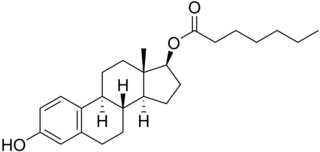
Estradiol valerate (EV), sold for use by mouth under the brand name Progynova and Primiwal E4 and for use by injection under the brand names Delestrogen and Progynon Depot among others, is an estrogen medication. It is used in hormone therapy for menopausal symptoms and low estrogen levels, hormone therapy for transgender people, and in hormonal birth control. It is also used in the treatment of prostate cancer. The medication is taken by mouth or by injection into muscle or fat once every 1 to 4 weeks.
Combined injectable contraceptives (CICs) are a form of hormonal birth control for women. They consist of monthly injections of combined formulations containing an estrogen and a progestin to prevent pregnancy.

Algestone acetophenide, also known more commonly as dihydroxyprogesterone acetophenide (DHPA) and sold under the brand names Perlutal and Topasel among others, is a progestin medication which is used in combination with an estrogen as a form of long-lasting injectable birth control. It has also been used alone, but is no longer available as a standalone medication. DHPA is not active by mouth and is given once a month by injection into muscle.

Norethisterone enanthate (NETE), also known as norethindrone enanthate, is a form of hormonal birth control which is used to prevent pregnancy in women. It is used both as a form of progestogen-only injectable birth control and in combined injectable birth control formulations. It may be used following childbirth, miscarriage, or abortion. The failure rate per year in preventing pregnancy for the progestogen-only formulation is 2 per 100 women. Each dose of this form lasts two months with only up to two doses typically recommended.

Estradiol enantate, also spelled estradiol enanthate and sold under the brand names Perlutal and Topasel among others, is an estrogen medication which is used in hormonal birth control for women. It is formulated in combination with dihydroxyprogesterone acetophenide, a progestin, and is used specifically as a combined injectable contraceptive. Estradiol enantate is not available for medical use alone. The medication, in combination with DHPA, is given by injection into muscle once a month.

Estradiol hexahydrobenzoate (EHHB), sold under a number of brand names including Benzo-Ginoestril A.P., BenzoGynoestryl Retard, Ginestryl-15-Depot, Menodin, and Tardoginestryl, is an estrogen medication which was previously used for indications such as menopausal hormone therapy and gynecological disorders. EHHB is given by injection into muscle at regular intervals, for instance once every few weeks.

Estradiol/norethisterone (E2/NET), tentative brand name Netagen or Netagen 403, was a combination of estradiol (E2), an estrogen, and norethisterone (NET), a progestin, which was studied as a birth control pill to prevent pregnancy in women. It was taken by mouth and contained 4 mg micronized E2 and 3 mg NET per tablet. The medication was developed by Novo Pharmaceuticals in Denmark and was never marketed.
Progestogen-only injectable contraceptives (POICs) are a form of hormonal contraception and progestogen-only contraception that are administered by injection and providing long-lasting birth control. As opposed to combined injectable contraceptives, they contain only a progestogen without an estrogen, and include two progestin preparations:

Estradiol benzoate butyrate (EBB), sold under the brand names Neolutin N, Redimen, Soluna, and Unijab and formerly known under the developmental code name Unimens, is an estrogen medication which is used in hormonal birth control for women. It is formulated in combination with dihydroxyprogesterone acetophenide, a progestin, and is used specifically as a combined injectable contraceptive. EBB is not available for medical use alone. The medication, in combination with DHPA, is given by injection into muscle once a month.

Estradiol/progesterone (E2/P4), sold under the brand names Bijuva and Juvenum, is a combined estrogen and progestogen medication which is used in the treatment of menopausal symptoms in postmenopausal women. It contains estradiol, an estrogen, and progesterone, a progestogen, and is available in both oral and intramuscular formulations. E2/P4 differs from other estrogen–progestogen formulations in that the sex-hormonal agents used are bioidentical.

Estradiol cypionate/medroxyprogesterone acetate (EC/MPA), sold under the brand name Cyclofem among others, is a form of combined injectable birth control. It contains estradiol cypionate (EC), an estrogen, and medroxyprogesterone acetate (MPA), a progestin. It is recommended for short-term use and is given once a month by injection into a muscle.

Estradiol valerate/norethisterone enantate (EV/NETE), sold under the brand name Mesigyna among others, is a form of combined injectable birth control which is used to prevent pregnancy in women. It contains estradiol valerate (EV), an estrogen, and norethisterone enantate (NETE), a progestin. The medication is given once a month by injection into muscle.

Estradiol valerate/hydroxyprogesterone caproate (EV/OHPC), sold under the brand names Gravibinon and Injectable No. 1 among others, is a combined estrogen and progestogen medication which is used in the treatment of threatened miscarriage and other indications and as a form of combined injectable birth control to prevent pregnancy. It contains estradiol valerate (EV), an estrogen, and hydroxyprogesterone caproate (OHPC), a progestin. The medication is given by injection into muscle once a day to once a month depending on the indication.

Estradiol enantate/algestone acetophenide, also known as estradiol enantate/dihydroxyprogesterone acetophenide (E2-EN/DHPA) and sold under the brand names Perlutal and Topasel among others, is a form of combined injectable birth control which is used to prevent pregnancy. It contains estradiol enantate (E2-EN), an estrogen, and algestone acetophenide, a progestin. The medication is given once a month by injection into muscle.

Estradiol/megestrol acetate (E2/MGA), sold under the brand names Mego-E and Chinese injectable No. 2, is a form of combined injectable birth control which is used in the People's Republic of China. It contains 3.5 mg estradiol (E2), an estrogen, and 25 mg megestrol acetate (MGA), a progestin. It is a microcrystalline aqueous suspension with a defined particle size range. The medication is given once per month by injection into muscle.

Estradiol benzoate butyrate/algestone acetophenide, also known as estradiol benzoate butyrate/dihydroxyprogesterone acetophenide (EBB/DHPA) and sold under the brand names Neolutin N, Redimen, Soluna, and Unijab, is a form of combined injectable birth control which is used in Peru and Singapore. It contains estradiol benzoate butyrate (EBB), an estrogen, and algestone acetophenide, a progestin. The medication is given once per month by injection into muscle.

Lynestrenol phenylpropionate (LPP), also known as ethynylestrenol phenylpropionate, is a progestin and a progestogen ester which was developed for potential use as a progestogen-only injectable contraceptive by Organon but was never marketed. It was assessed at doses of 25 to 75 mg in an oil solution once a month by intramuscular injection. LPP was associated with high contraceptive failure at the low dose and with poor cycle control. The medication was found to produce estrogenic effects in the endometrium in women due to transformation into estrogenic metabolites.

Estradiol valerate/methenmadinone caproate (EV/MMC), known by the tentative brand name Lutofollin, is a combination medication of estradiol valerate (EV), an estrogen, and methenmadinone caproate, a progestin, which was developed for potential use as a once-a-month combined injectable contraceptive but was never marketed. It contained 10 mg EV and 60 mg MMC in 1 mL oil solution and was intended for administration by intramuscular injection once every 4 weeks.

Polyestradiol phosphate/medroxyprogesterone acetate (PEP/MPA) is a combination of polyestradiol phosphate (PEP), an estrogen, and medroxyprogesterone acetate (MPA), a progestin, which was studied in the 1960s as a long-lasting combined injectable contraceptive for women but was never marketed. It was administered by intramuscular injection once every 3 months and contained 40 mg PEP and 150 mg MPA. The combination was studied in a sample of 99 premenopausal women and was found to be effective in preventing pregnancy, but caused menstrual irregularities similar to those of MPA alone as a progestogen-only injectable contraceptive. PEP was included in the formulation to prevent estrogen deficiency and reduce menstrual abnormalities caused by MPA during long-term contraceptive therapy.

Estradiol valerate/megestrol acetate (EV/MGA) is a combined injectable contraceptive which was developed in China in the 1980s but was never marketed. It is an aqueous suspension of microcapsules containing 5 mg estradiol valerate (EV) and 15 mg megestrol acetate (MGA). It was also studied at doses of EV ranging from 0.5 to 5 mg and at doses of MGA ranging from 15 to 25 mg.











